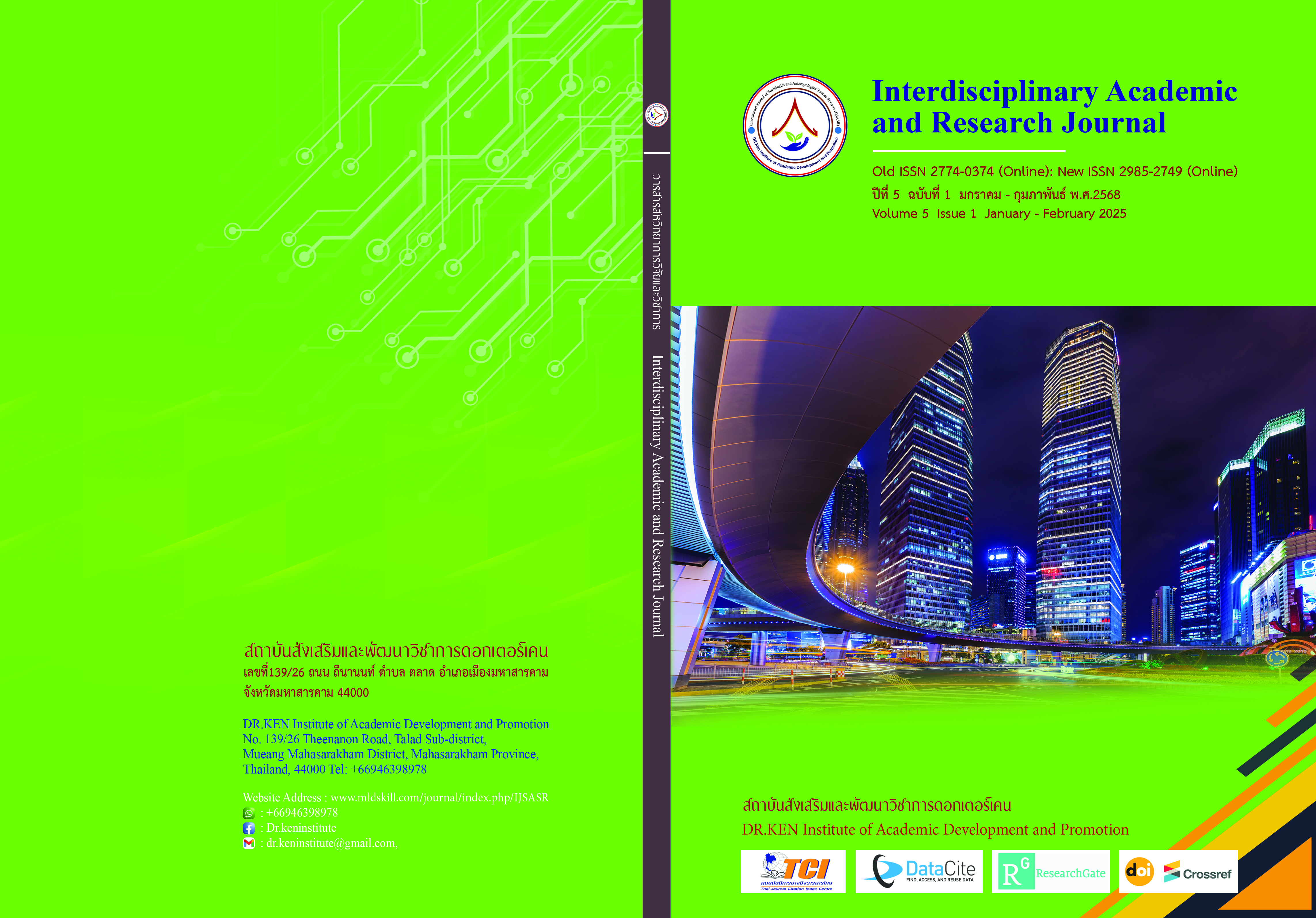อุปสรรคทางกฎหมายในการค้าไม้เศรษฐกิจภายในพื้นที่ปฏิรูปที่ดินเพื่อเกษตรกรรม
DOI:
https://doi.org/10.60027/iarj.2025.279243คำสำคัญ:
ที่ดิน, ไม้เศรษฐกิจ, ป่าไม้บทคัดย่อ
ภูมิหลังและวัตถุประสงค์: ในพื้นที่ปฏิรูปที่ดินเพื่อเกษตรกรรม กฎหมายที่ควบคุมการค้าไม้รับประกันการจัดการป่าไม้อย่างยั่งยืนโดยไม่สนับสนุนการตัดไม้ทำลายป่าและส่งเสริมการอนุรักษ์สิ่งแวดล้อม พวกเขายังส่งเสริมเสถียรภาพทางเศรษฐกิจ ปกป้องสิทธิของเจ้าของที่ดิน และรักษาสมดุลระหว่างการผลิตไม้และการเกษตรเพื่อความอยู่ดีมีสุขทางนิเวศวิทยาและเศรษฐกิจในระยะยาว การวิจัยฉบับนี้มีวัตถุประสงค์เพื่อศึกษาการค้าไม้เศรษฐกิจภายในที่ดินที่ปฏิรูปเพื่อเกษตรกรรม และหาแนวทางในการแก้ไขกฎหมายที่เป็นอุปสรรคในการค้าไม้เศรษฐกิจในที่ดินดังกล่าว
ระเบียบวิธีการวิจัย: งานวิจัยฉบับนี้เป็นระเบียบวิธีการวิจัยเชิงคุณภาพ โดยศึกษาจากเอกสาร งานวิชาการอื่น ๆ รงมถึงเอกสารทางอิเล็กทรอนิกส์
ผลการวิจัย: ปัจจุบันมีการแก้ไขพระราชบัญญัติป่าไม้ พ.ศ. 2484 ในมาตรา 7 จากเดิมกำหนดให้ไม้เศรษฐกิจมีสถานะเป็นไม้หวงห้าม การจะครอบครอง ทำ ตัด แปรรูปไม้ จะต้องได้รับอนุญาตจากพนักงานเจ้าหน้าที่ ไม่ว่าไม้นั้นจะขึ้น ณ ที่ใดก็ตามในราชอาณาจักร หากฝ่าฝืนจะมีโทษทางอาญา แต่ในการแก้ไขเพิ่มเติมพระราชบัญญัติป่าไม้ พ.ศ. 2484 (ฉบับที่ 8) กำหนดเกี่ยวกับไม้หวงห้ามที่ขึ้นอยู่ในที่ดินที่มิใช่ป่า สามารถตัดไม้ยืนต้นได้โดยไม่ผิดกฎหมายในที่ดินกรรมสิทธิ์หรือสิทธิครอบครอง รวมถึงในที่ดินตามหนังสือแสดงสิทธิ์
สรุปผล: ผู้เขียนพบปัญหาว่าแม้กฎหมายฉบับใหม่จะอนุญาตให้เจ้าของที่ดินที่มีกรรมสิทธิ์หรือสิทธิครอบครองสามารถ ตัด ฟัน โค่น ฯลฯ ไม้ที่ขึ้นในที่ดินดังกล่าว แต่ในทางกลับกันที่ดินที่ได้รับอนุญาตให้ทำประโยชน์ตามประเภทหนังสือแสดงสิทธิ กฎหมายแก้ไขให้ต้องเป็นไม้ที่ปลูกขึ้นเท่านั้นจึงจะตัดได้ สังเกตว่าสองกรณีนี้แตกต่างกัน กล่าวคือ ที่ดินที่ได้รับอนุญาตให้ทำประโยชน์ตามประเภทหนังสือแสดงสิทธิ ไม่สามารถที่จะตัดไม้ที่ขึ้นเองตามธรรมชาติได้ ทั้ง ๆ ไม้เศรษฐกิจเหล่านี้ไม่ว่าจะขึ้นเองตามธรรมชาติ หรือมนุษย์ปลูกขึ้น ผลก็คือต้องการให้เกิดการส่งเสริมการค้าไม้เศรษฐกิจอยู่ดี ซึ่งขัดกับหลักการของการแก้ไขกฎหมายฉบับดังกล่าว งานวิจัยฉบับนี้จึงเสนอแนะให้มีการแก้ไข พระราชบัญญัติป่าไม่ พ.ศ. 2484 อีกครั้งให้ถูกต้องตามหลักการและหตุผล
เอกสารอ้างอิง
ธเนศ อาภรณ์สุวรรณ. (2567). ที่ดินทั้งหลายในแว่นแคว้นกรุงศรีอยุธยาฯ เป็นของสมเด็จพระเจ้าอยู่หัว โดยพระบรมเดชานุภาพ’ สู่ ‘ที่ดินกึ่งรัฐ-กึ่งเอกชน’. Retrived from: https://www.matichonweekly.com/column /article_753034
นันท์นภัส นิธิเมธธีรนนท์. (2564). การจัดหาที่ดินเพื่อการปฏิรูปที่ดินเพื่อเกษตรกรรม. Graduate Law Journal, 14(3), 409-433. https://so01.tci-thaijo.org/index.php/gradlawtujournal/article/view/246740/168380
มหาวิทยาลัยเกษตรศาสตร์. (2542). การดำเนินการเกี่ยวกับกรรมสิทธิ์ที่ดิน “ป่าสงวน”. Retrived from: https://web.ku.ac.th/king72/2542-09/res03_03.html
วนิดา อินทรอำนวย. (2549). กฎหมายว่าด้วยสวนป่าฉบับแก้ไขเพิ่มเติม. Retrived from: https://www.parliament.go.th/ewtadmin/ewt/elaw_parcy/ewt_dl_link.php?nid=1547
วุฒิไกร ผิวขาว. (2564). มาตรการทางกฎหมายในการส่งเสริมการปลูกป่าเศรษฐกิจ : ศึกษากรณีพื้นที่อำเภอเทพสถิต จังหวัดชัยภูมิ. วิทยานิพนธ์นิติศาสตรมหาบัณฑิตย์: มหาวิทยาลัยธรรมศาสตร์.
สราวุธ อุเทนรัตน์. (2566). การส่งเสริมปลูกไม้เศรษฐกิจเพื่อธุรกิจค้าไม้ : กรณีศึกษาไม้พะยูง. วารสารรัฎฐาภิรักษ์, 65(2), 79-94.
สำนักงานการปฏิรูปที่ดินเพื่อเกษตรกรรม. (2563). ความเป็นมาของปฏิรูปที่ดิน. Retrived from: https://alro.go.th/th/alro /news-activity/page-13639/ประวัติความเป็นมา?id=143614
สำนักงานคณะกรรมการกฤษฎีกา. (2565). พระราชบัญญัติป่าไม้ พ.ศ. 2484. สำนักนโยบายและแผนทรัพยากรธรรมชาติและสิ่งแวดล้อม. https://www.forest.go.th/law/wp-content/uploads/sites/33/2022/02/พระราชบัญญัติป่าไม้-พุทธศักราช-2484-และที่แก้ไขเพิ่มเติม-2.pdf
แสงอรุณ อนุเคราะห์ และเจตนนาฎ สุวรรณดี. (2564). ไม้มีค่า….ไม้เศรษฐกิจ. Retrived from: https://library.parliament.go.th/th/digest/digest-2564-jun14
อุดมศักดิ์ สินธิพงษ์. (2554). กฎหมายเกี่ยวกับสิ่งแวดล้อม. พิมพ์ครั้งที่ 3. กรุงเทพฯ : วิญญูชน.
ดาวน์โหลด
เผยแพร่แล้ว
รูปแบบการอ้างอิง
ฉบับ
ประเภทบทความ
สัญญาอนุญาต
ลิขสิทธิ์ (c) 2025 Interdisciplinary Academic and Research Journal

อนุญาตภายใต้เงื่อนไข Creative Commons Attribution-NonCommercial-NoDerivatives 4.0 International License.
ลิขสิทธิ์ในบทความใดๆ ใน Interdisciplinary Academic and Research Journal ยังคงเป็นของผู้เขียนภายใต้ ภายใต้ Creative Commons Attribution-NonCommercial-NoDerivatives 4.0 International License การอนุญาตให้ใช้ข้อความ เนื้อหา รูปภาพ ฯลฯ ของสิ่งพิมพ์ ผู้ใช้ใดๆ เพื่ออ่าน ดาวน์โหลด คัดลอก แจกจ่าย พิมพ์ ค้นหา หรือลิงก์ไปยังบทความฉบับเต็ม รวบรวมข้อมูลเพื่อจัดทำดัชนี ส่งต่อเป็นข้อมูลไปยังซอฟต์แวร์ หรือใช้เพื่อวัตถุประสงค์ทางกฎหมายอื่นใด แต่ห้ามนำไปใช้ในเชิงพาณิชย์หรือด้วยเจตนาที่จะเป็นประโยชน์ต่อธุรกิจใดๆ

















